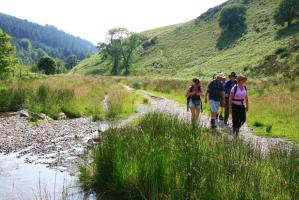What is Thru-Hiking?
Thru-hiking refers to walking a long-distance trail from end to end, typically over multiple weeks or even months. It’s not just about hiking—it’s about embracing the rhythm of the trail, day after day, carrying only what you need, and immersing yourself in nature and local culture along the way.
While the term gained fame on American trails like the Appalachian Trail or Pacific Crest Trail, it's now becoming more popular in Europe, too—where centuries-old pilgrimage routes, GR paths, and transnational trails offer incredible thru-hike experiences.
Is thru-hiking for me?
Thru-hiking doesn’t mean you need to walk for three months straight or sleep in a tent every night. Many routes in Europe can be broken into stages or done with accommodation and luggage transfers—ideal for those who want the thru-hike feeling without going full minimalist.
.png) |
.png) |
How to prepare physically
Even if you're in shape, thru-hiking is physically demanding. Here some tips to get ready:
- Start training 8–12 weeks before your trip
- Aim for long walks with a loaded backpack, building up to 4–6 hour hikes with elevation gain
- Mix in strength & mobility
- Focus on legs, core, and back. You can add exercises like lunges, squats, planks, and yoga
- Break in your footwear
- This cannot be overstated—blisters are the enemy!
- Test your gear - especially if it's new
Popular thru-hikes in Europe
Camino de Santiago (Spain)
- Distance: about 770 km (the French Way)
- From: Saint-Jean-Pied-de-Port (France) to Santiago de Compostela (Spain)
- Days: 30 to 35 days
- A cultural and/or spiritual pilgrimage with plenty of infrastructure—ideal for first-time thru-hikers.
GR20 (Corsica, France)
- Distance: about 180 km
- From: Calenzana to Conca
- Days: 13 to 16 days
- Famous for its rugged terrain and alpine views—one of Europe’s most challenging hikes due to the significant elevation changes.
Via Francigena (UK to Italy)
- Distance: about 2,500 km
- From: Canterbury to Rome
- Days: 90+ days (or in sections)
- A pilgrimage crossing England, France, Switzerland, and Italy. History and diversity in every step. Very good infrastructure from Switzerland as it is busier in Italy.
Coast to Coast Path (England)
- Distance: about 320 km
- From: St Bees to Robin Hood's Bay
- Days: 12 to 15 days
- Wainwright’s Coast to Coast Walk is by far the most popular long distance trail in Britain, and one of the world’s great walks. On the way it passes through three National Parks: The Lake District, the Yorkshire Dales and the North York Moors.
Rota Vicentina (Portugal)
- Distance: 227 km (Fisherman’s Trail)
- From: Porto Covo to Lagos
- Days: 12 to 15 days
- Coastal cliffs, wild Atlantic beaches, and charming rural villages. A great way to experience authentic Portuguese life, far from the more touristy areas.
E5 European Long Distance Path (Alps section)
- Distance: about 600 km (Lake Constance to Verona)
- From: Oberstdorf (Germany) to Verona (Italy)
- Days: 30 to 35 days
- A trans-Alpine hike crossing Germany, Austria, and Italy. Alpine passes, green meadows, and cultural mix. Hostels and mountain huts available along the whole route.
Gear tips for thru-hikers
- Pack light: Every gram matters over hundreds of kilometres.
- Layer wisely: Weather can change drastically, even in summer.
- Don’t forget foot care: Compeed, tape, and quality socks can save your trip.
- Hydration & snacks: Refill often and keep energy high.
.png) |
.png) |
When to go
Most European thru-hikes are best between May and October, but this varies:
- Alpine routes (GR20, E5): July–September
- Mediterranean & coastal (Rota Vicentina, Camino): March–June or September–November
- UK trails: May–September for the best weather window
Go your own way
Thru-hiking doesn’t have to mean wild camping and 20 kg backpacks. With self-guided packages, you can focus on the walking—while your luggage gets transferred and your accommodation is booked in advance. Europe is perfect for this style: authentic, flexible and full of unforgettable trails.
Marketing, Web & Design
After studying in my hometown of Barcelona and spending several years abroad, I relocated in 2018 to Cabrales, a beautiful rural area in Northern Spain. I invite you to check out some photos of Cabrales to see the incredible views we enjoy from our office!
After a few years in reservations, I now manage the website and marketing for S-Cape Travel, where I handle design tasks, blog writing, and attend specialized travel fairs.

















Opening hours: Mon-Fri 9:00am – 6:00pm (CET)
Opening hours: Mon-Fri 9:00am – 6:00pm (CET)